Unique Partnership Between Dancers and
Cognitive Scientists Underscores Interdisciplinary Focus at UCSD
Barry Jagoda | February 23, 2008
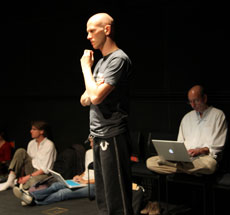
Famed British choreographer
Wayne McGregor, "Innovator-in-Residence"
at UCSD partners with UC San Diego
Cognitive Scientist David Kirsh.
(Photo / Adriene Hughes)
Eleven stars under the direction of British dance sensation Wayne McGregor, choreographer of “Wayne McGregor’s Random Dance Company,” have been in residence at UC San Diego for most of February preparing for the world premiere of a new production scheduled for fall, 2009. In a unique interdisciplinary partnership, their every move in rehearsal and performance has been documented by David Kirsh, a professor of cognitive science, and students from two classes he created to study cognition and the arts.
One of the dancers, Agnes Lopez Rio, expressed the impact of the cognitive scientists on the company, “We have become more aware of our habits. I have definitely broadened my perspective and working with David (Kirsh) makes me realize something about my habits.”
This collaboration is one of the most visible marriages of academics with a variety of arts at UCSD. In this case, the relationship began three years ago when Martin Wollesen, artistic director of ArtPower! and director of the University Events Office, was seeking a way to take advantage of the UCSD academic environment at the same time that then Provost of Sixth College, Gabriele Wienhausen, was in her perpetual search for ways of getting her undergraduate students experiences beyond the classroom.
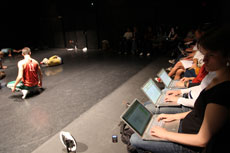
Cognitive Science students monitor
every move of dancers from "Wayne McGregor's Random Dance Company"
(Photo / Adriene Hughes)
“Culture is what makes us human and that is what we explore, looking at it through the lens of art and technology," explains Wienhausen, "Students are required to have real world experience. The way we have learned to do this over the years is to get students 'rattled,' so they can stop their old patterns and gain, through out of class experience new ways of seeing the world. This takes courage, imagination and inspiration. If we can establish relationships between the student and outside influences that have a dynamic practical effect then we are underway. We did this with the brilliant choreographer Wayne McGregor, who shared this vision, when he was first on campus in 2007. Working with Marty Wollesen, we set up a Wayne McGregor Workshop where he talked about his profession and what it means to be creative and how you can begin to understand yourself."
“Interdisciplinary work can take hold at UCSD if you find an in-depth project that reflects the kind of university we are,” said Wollesen. “We have the college system with a general education program that supports multidisciplinary studies. And, at Sixth College, for example, with a focus on real-world experiences, we have had a leader in Gabriele Wienhausen who is passionate and enthusiastic, a real visionary who has become an on-going partner for our arts programs combined with academic studies.”
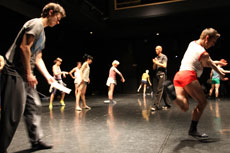
Wayne McGregor's Random Dance Company prepares for world premiere in partnership with UC San Diego cognitive science specialists.
(Photo / Adriene Hughes)
The ArtPower! residency program is called "Innovator-in-Residence Project," and it requires that the visitor be both innovative in the artistic field and also interested in the future of scientific research. Wayne McGregor, for example has an interest in the field of ataxia, the syndrome that leads to the inability to control one’s muscles. Said Wollesen, “Wayne is one of the globe’s leading choreographers, very greatly respected in the world of contemporary dance, resident choreographer at England’s Royal Ballet and in residence at the famous Sadler’s Wells dance venue, while also deeply interested in how his work can benefit from the contributions of science.”
A hallmark of the arts at UCSD, working in the environment of some of the nation’s strongest programs in the sciences and social sciences, has been to benefit from this context. Here, musicians work closely with computer scientists, philosophers collaborate with neuroscientists and, in this current, closely-watched program, performing artists have their work enhanced by those who study the intricate details of human cognition.
“The research has been delivering results from the first day,” said Kirsh. “One major area focuses on instructions: What sort of tasks does Wayne give the dancers? Which ones work and how? How does he work with the creative results of each dancer and modify it, morphing it in the direction that fits his larger conception. How are the dancers used as things to think with? What is the nature of choreographic thinking? How does distributed problem solving work in this sort of domain? We have learned something already in each of these areas.
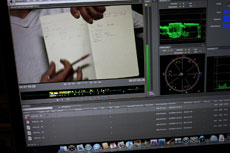
Cognitive Scientists employ
photo documentation and detailed
monitoring of dancers movements.
(Photo / Adriene Hughes)
"The discoveries we're making about these topics have general value beyond the domain of dance. For instance, instructions are of universal concern, whether they be instructions to workers in factories, instructions to home cooks presented in the form of recipes, instructions for furniture assembly, or classroom instructions in labs, exams and so on. Choreographers use more modalities than most people. They gesture continuously, they speak, of course, and they use musical or phonetic sounds "woooo-aahhh-ka-daaah". They even push and pull on bodies. There has been little study of how these different modalities figure in getting people to do the right thing.
“Another thing we have been learning is how memory can be distributed across a team. The choreographer assigns names to exercises and dance phrases, but doesn't bother to memorize all the solutions and partial solutions the dancers produce. He requests their solutions in the future and then counts on them recalling them. It turns out that individual people have memory for different aspects of a phrase: one remembers its kinetics, another its emotionality or its dynamics, a third remembers precise details of where the fingers were placed on another body. The team as a whole recovers the phrase.
“And then there is the question of how this artistic product is supposed to be made sense of by an audience. This too is more general than dance, because it concerns how a creative effort in one field strives to be understandable to non-specialists.”
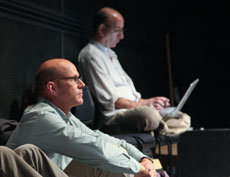
Martin Wollesen, artistic director of UC San Diego Art Power, and David Kirsh, professor
of cognitive science observe the dancers.
(Photo / Adriene Hughes)
It is clear that McGregor knows the benefit from the UCSD collaboration, particularly what part of the scientific process is relevant for him and what is surplus: “I’m not interested in their coding of our interaction,” he said. “I have a relationship with the dancers where they have to provide answers, body images and that is my focus. David is starting to help us understand this process. I am interested in the specificity of why they are building an image. Is it controllable? We are able to respond to some of the articulations between me and the dancers. They are extending my ability to work with the body. What is the direct connection between what they are thinking about and how they go about constructing a move and how they eventually produce a complete result?”
UCSD not only has the talent for this kind of multi-discipline learning process, but the university has a strong desire for interdisciplinary study with vigorous support from Chancellor Marye Anne Fox. Her office has funded 21 such projects, under a program called “Interdisciplinary Collaboratories.”
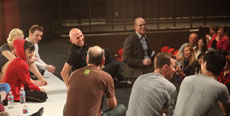
Wayne McGregor and his
Random Dance Company, along
with David Kirsh and Martin Wollesen,
invited the public to an open rehearsal.
(Photo / Adriene Hughes)
And a special inducement comes from the technological environment. For example, as part of dance-cognition study, the extraordinary facilities of Calit2 were called into play. Here, interviews by the cognitive science students of the dancers could be captured in high definition and played back in ways that made discussion and evaluation much more useful than on standard equipment.
“Random Dance” will present the as yet unnamed world premier of the production in the fall of 2009 at Sadler’sWells in London.

|